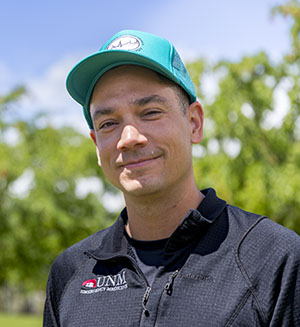Preparing for Disaster: UNM Hospital Participates in Region-Wide Emergency Training

Elevated Research
UNM Team Joins U.S. Army Scientists Studying Acute Mountain Sickness
A lone mule deer grazing in a meadow greets Jon Femling, MD, PhD, as he coaxes his Chevy Suburban up a steep, winding gravel road above the Taos Ski Valley to a pair of structures perched nearly 12,000 feet up the mountainside.
“We come up here and teach in this environment all the time,” says Femling, an associate professor in The University of New Mexico Department of Emergency Medicine and a member of UNM’s International Mountain Medicine Center.
Over the past few weeks, Femling and his colleagues (and the local wildlife) have been joined in New Mexico’s high country by the participants in unique research project.
Beth Beidleman, ScD, a physiologist with the U.S. Army Research Institute of Environmental Medicine (USARIEM), is testing a new method to predict who is likely to succumb to acute mountain sickness when rapidly ascending to high elevations. Her research subjects are fit volunteers from the Army’s 5th Engineer Battalion, based at Fort Leonard Wood in south-central Missouri.
The Mountain Medicine team’s primary role is to keep the troops safe in the mountains, but they also help draw blood and lead them on hikes up nearby Kachina Peak (elevation 12,481 feet), Femling says.
The UNM personnel also carry oxygen and medications in case someone has a severe reaction and conduct training on how to safely evacuate a patient from a rugged backcountry setting. “Safety is absolutely paramount,” he says.
Each group of soldiers, who live at about 1,000 feet above sea level, flies into the Albuquerque International Sunport (about a mile high) and then drives three hours up to the ski valley, which sits at about 9,300 feet.
Half of the group are outfitted with biosensors and rucksacks that total 15% of their body weight and sent trudging up the hill. The remainder ride up in SUVs. The road tops out at the ski patrol headquarters and an adjacent maintenance building, which serves as a bunkhouse and makeshift laboratory while the subjects spend their four-day rotations on site.
The soldiers regularly submit blood, urine and saliva samples and have blood oxygenation and other readings taken from the sensors.
Acute mountain sickness has well-defined symptoms, including headache, gastrointestinal distress, fatigue, dizziness and sleep disturbance. At sea level most people have a blood oxygen saturation level of 95 percent or better, but in the thin air at higher elevations, it can drop into the 80 percent range or even lower.
Yet not everyone suffers symptoms, even with lower-than-normal oxygen levels, says Beidleman, who has been researching the subject for 30 years.
“We’ve developed an algorithm for acute mountain sickness to predict those individuals likely to suffer acute mountain sickness so they do not become a casualty,” she says. The current round of testing is intended to validate her methodology, which identifies unique physiologic and genetic variations that predispose someone to have symptoms.
In a pilot study, “We took a baseline blood sample,” she says. “We found a set of 20 messenger RNAs that were differentially regulated and want to confirm those findings in this study.”
USARIEM has for many years maintained a research laboratory atop Pikes Peak in Colorado, whose summit is 14,115 feet, but that turns out to be too high for the Army’s purposes, Beidleman says.
The high peaks around the Taos Ski Valley top out at just over 13,000 feet, and most are 500 to 1,000 feet lower. “That’s a very military-relevant altitude that soldiers could be deployed to,” she says. “We don’t have a whole lot of data for how soldiers will respond at 12,000 feet.”
She credited the UNM Mountain Medicine team for tending to the participants’ well-being. “It makes me very confident that our volunteers are safe,” Beidleman says. “It’s a real win for both groups.”
Femling says UNM’s partnership with USARIEM evolved over several years thanks to a suggestion by an Army researcher, Reed Hoyt, MD, who graduated from the School of Medicine. The testing in Taos was due to launch in 2020 but had to be postponed due to the COVID-19 pandemic.
“This may be the largest altitude study of its kind,” he says. “We’re already talking about what we can do next year.”

This may be the largest altitude study of its kind.